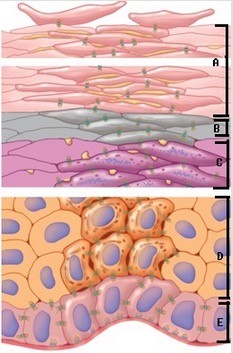 The figure illustrates the layers of the epidermis. Which layer of the epidermis is "B"?
The figure illustrates the layers of the epidermis. Which layer of the epidermis is "B"?
A. Stratum spinosum
B. Stratum lucidum
C. Stratum granulosum
D. Stratum basale
E. Stratum corneum
Answer: B
You might also like to view...
Disorders involving the vagus nerve might cause
A) food to remain in your stomach longer. B) a drop in blood pressure. C) constriction of the pupils. D) more saliva production. E) increased sweating.
Fatty acids enter the cell respiration pathway at
A. the citric acid cycle, once they have been converted to acetyl CoA. B. glycolysis, once they have been converted to glucose. C. electron transport chain, once they have been converted to NADH. D. the intermediate stage, once they have been converted to pyruvate.
You see a female patient in the emergency room with severe, intermittent "loin" (lumbar region) pain who is also having great difficulty urinating. Your most likely first diagnosis is:
A) kidney disease. B) ureteric ischemia. C) ruptured renal artery. D) ectopic pregnancy. E) ureteric calculus.
Distinguish between the conducting portion and respiratory portion of the respiratory tract
A) The conducting portion includes the nasal cavity and extends through the pharynx, larynx, trachea, bronchi, and larger bronchioles. The respiratory portion includes the respiratory bronchioles and alveoli. B) The conducting portion of the respiratory tract includes the respiratory bronchioles and alveoli. The respiratory portion includes the nasal cavity and extends through the pharynx, larynx, trachea, bronchi, and larger bronchioles. C) The conducting portion includes the nasal cavity and extends through the pharynx and larynx. The respiratory portion includes the trachea, bronchi, larger bronchioles, respiratory bronchioles and alveoli. D) The conducting portion includes the trachea, bronchi, larger bronchioles, respiratory bronchioles and alveoli. The respiratory portion includes the nasal cavity and extends through the pharynx and larynx. E) The conducting portion includes the nasal cavity and pharynx. The respiratory portion includes the larynx, trachea, bronchi, larger bronchioles, respiratory bronchioles, and alveoli.